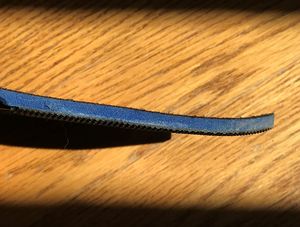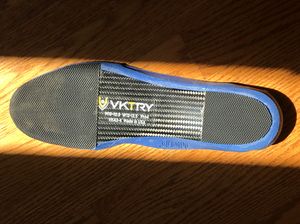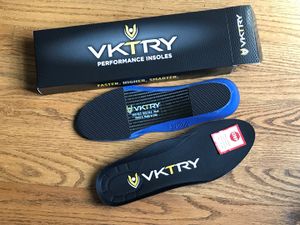VKTRY Insoles
VKTRY insoles are a springy carbon fiber plate with some foam padding over the top. The idea of VKTRY insoles is to provide extra spring that propels you forward, improving [[Running Economy]. The Nike Vaporfly 4% also uses a carbon fiber plate, but the Vaporfly buries the plate within the midsole. Without access to a laboratory, it's hard to know if these insoles actually improve running economy or not. I couldn't find any research that uses the VKTRY insoles that directly supports them improving running economy, though there is a study that showed a 1% improvement when a carbon fiber plate is inserted into the midsole of a running shoe[1]. A 1% improvement in running economy would be hard to perceive, though it could make an important difference to your race performance. Personally, I found too many problems with the VKTRY insoles for them to be viable.
- Putting the carbon fiber plate above the midsole means that you effectively lose most of the shoes cushioning. Imagine putting a sheet of wood on your mattress, and lying on it. Even though there is the same underlying cushioning, because your weight is spread more evenly there is far less give. I tried these insoles in a variety of different shoes, but I always found the lack of cushioning to be an issue. The insoles do have some cushioning over the carbon fiber plate but not enough to help much.
- Using the VKTRY insoles in a minimalist/barefoot running shoe doesn't have the cushioning problems. The lack of cushioning in a minimalist shoe reduces your running economy, so it's possible that these insoles could help offset that deficit somewhat. Personally, when I'm using minimalist running shoes it's because they are minimalist, and a carbon fiber plate goes against that idea rather fundamentally. The insoles also weight 2.3oz, which is significant in a truly minimalist running shoe.
- Being made of carbon fiber, it would be tough to trim the insoles to shape without metal cutting equipment. Even then, I'd be reluctant to start hacking such an expensive item apart without a lot more experience in working on carbon fiber. The insoles are a reasonably standard running shoe shape, which means they are not going to fit a shoe like an Altra that's designed to mimic the shape of the human foot. In fact, I found it hard to fit these insoles into running shoes because of the lack of flexibility in the shape.
- The carbon fiber plate is only about 1 mm thick, but the foam padding over the top makes the forefoot 5.4mm and the heel 6.7mm. that's thicker than most insoles, so I found the fit was badly compromised in most of the shoes I tried them in.
- The VKTRY insoles retail for $200, which makes them a little pricey for most runners. I suspect the carbon fiber plate will last a long time, but I would also expect the foam padding that goes over the plate will break down rather more quickly.
In conclusion, the VKTRY insoles didn't work for me. However, the company offers a 30-day moneyback guarantee, so you can try them risk free. I suspect we will see far more carbon fiber in our running shoes in the future, but I think it will be embedded lower in the midsole.
References
- ↑ Jean-Pierre R. Roy, Darren J. Stefanyshyn, Shoe Midsole Longitudinal Bending Stiffness and Running Economy, Joint Energy, and EMG, Medicine & Science in Sports & Exercise, volume 38, issue 3, 2006, pages 562–569, ISSN 0195-9131, doi 10.1249/01.mss.0000193562.22001.e8


